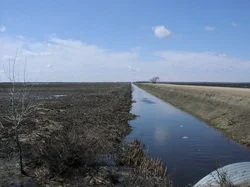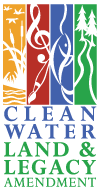Kittson SWCD Reports & Publications
Annual Report Summary
-
2024 Work Plan
2023 Work Plan
2022 Work Plan
-
2024 MDA Report
2023 MDA Report
2022 MDA Report
-
2024 Annual Audit
2023 Annual Audit
2022 Annual Audit
Kittson County Local Water Plan
The Kittson County Local Water Plan (CLWP) is a comprehensive analysis of water and related land resources coupled with a recommended series of action strategies designed to achieve maximum water resource use and achieve water management goals. The plan has been developed under the legislative authority and mandate of the County Local Water Management Act (Minnesota Statutes, Chapter 110B) and its associated State Rule (MCAR, Chapter 9300).
The Kittson SWCD is currently working on the new One Watershed One Plan for the Two Rivers Plus planning region. For more information on this planning process please visit www.tworiversplus1w1p.org.
2023 Dues
NACD = $250.00
MASWCD = $4,168.04
MACFO = $125.00
NACDE = $40.00
MCAI = $85.00
MACDE = $100.00
MASWCD Area I = $150.00
Natural Resources Block Grant (NRBG)
The Natural Resources Block Grant (NRBG) is a composite of base grants available to local government units that help them implement programs designed to protect and improve water resources.
Individual programs under this grant include:
Comprehensive Local Water Management
Wetland Conservation Act
DNR Shoreland Management Program
Minnesota Pollution Control Agency Feedlot Permit Program
MPCA Individual Sewage Treatment Systems Program
Comprehensive Local Water Plan (CLWP)
As a general-purpose unit of government, counties, with their planning and land-use authorities, are uniquely positioned to link many land-use decisions with local goals for surface and groundwater protection and management. Through the Comprehensive Local Water Management Act (Act), counties are encouraged to make this link through the development and implementation of comprehensive local water management plans (county water plans).
According to the Act, these county water plans must:
cover the entire area within a county;
address water problems in the context of watershed units and groundwater systems;
be based upon principles of sound hydrologic management of water, effective environmental protection, and efficient management; and
be consistent with local water management plans prepared by counties and watershed management organizations wholly or partially within a single watershed unit or groundwater system.
County Commissioners also are responsible for appointing Watershed District Managers (see Watershed District Manager Appointments fact sheet)
BWSR's role in local planning is to ensure that county water plans are prepared and coordinated with existing local, and state efforts; and that plans are implemented effectively. BWSR fulfills this role through Board review and approval of the plans while BWSR staff members provide overall program guidance, process affiliated grants, and provide plan review and comments.
All parts of Minnesota have state-approved and locally-adopted county water plans in place. However, water management in Minnesota recently began an evolution towards watershed-based, rather than jurisdictional based water plans.
Sub Surface Treatment Systems (SSTS)
Based on 1997 changes to Minnesota Statutes, all counties are required to pass ordinances regulating Individual Sewage Treatment Systems countywide. These ordinances were required to be in compliance by Jan. 1, 1999. All counties that have enacted countywide ordinances are eligible to receive this grant.
DNR Shoreland
The Community Stewardship Unit oversees the administration of the state shoreland management program to promote wise development of shorelands in order to preserve and enhance the quality of surface waters, preserve the economic values of shorelands, and ensure the wise use of water and related resources.
Feedlot
This program was created to protect water quality by improving animal waste treatment systems on feedlots.
A county feedlot program is established by transferring of regulatory authority from the Minnesota Pollution Control Agency to the county. This transfer of authority is granted by statute and it allows the Minnesota Pollution Control Agency to "delegate" administration of certain parts of the feedlot program to counties.
County feedlot programs have the responsibility for implementing state feedlot regulations including: registration; permitting; inspection; education and assistance; and compliance follow-up.
Wetland Conservation Act (WCA)
The purpose of the Wetland Conservation Act (WCA) is to maintain and protect Minnesota's wetlands and the benefits they provide.
In 1991, the Minnesota Legislature approved the Wetland Conservation Act. The project began in 1993 in response to concerns about wetland management processes such as permitting, unclear state policies, and methods to achieve the state's goal of no net loss of wetlands.
The law requires anyone proposing to drain or fill a wetland first to try the following:
To avoid disturbing the wetland;
Try to minimize any impact on the wetland; and
Replace any lost wetland acres, functions, and values.
Minnesota's Wetland Conservation Act is considered one of the most comprehensive wetland laws in the country. It recognizes a number of benefits wetlands provide, including:
Water quality benefits, including filtering pollutants out of surface water and groundwater, using nutrients that would otherwise pollute public waters, trapping sediments, protecting shoreline, and recharging groundwater supplies;
Floodwater and storm water retention benefits, including reducing the potential for flooding in the watershed;
Public recreation and education benefits, including hunting and fishing areas, wildlife viewing areas, and nature areas;
Commercial benefits, including wild rice and cranberry growing areas and aquaculture areas;
Fish and wildlife benefits;
Low-flow augmentation benefits during times of drought; and
Other public uses.
Ag BMP Loan Program
The Ag BMP Loan Program provides low interest loans to farmers, rural landowners and agriculture supply businesses. The purpose is to encourage Best Management Practices that prevent or reduce water quality problems.
State Cost Share
The State Cost-Share Program was created to provide funds to Soil and Water Conservation Districts to share the cost of systems or practices for erosion control, sedimentation control, or water quality improvements that are designed to protect and improve soil and water resources. Through the State Cost-Share Program, land occupiers can request financial and technical assistance from their local District for the implementation of conservation practices. Kittson SWCD priority resource concerns include surface water quality, drinking water quality and flood damage reduction.
Farmstead Shelterbelt planted in 2013
Farmstead Shelterbelt 3 months after planting - 2014
Hallock Township Streambank Stabilization 2014
Clean Water Fund 2011 Lake Bronson Watershed Runoff Reduction Grant - Phase I
On November 4, 2008, Minnesota voters approved the Clean Water, Land & Legacy Amendment to the constitution to:
protect drinking water sources
protect, enhance, and restore wetlands, prairies, forests, and fish, game, and wildlife habitat
preserve arts and cultural heritage
support parks and trails
and protect, enhance, and restore lakes, rivers, streams, and groundwater
The Amendment increases the sales and use tax rate by three-eighths of one percent on taxable sales, starting July 1, 2009, continuing through 2034. Those dollars are dedicated to four funds: Outdoor Heritage Fund, Clean Water Fund, Parks and Trails Fund, and Arts and Cultural Heritage Fund.
BWSR has received appropriations from the Outdoor Heritage Fund and the Clean Water Fund. Specifics about projects funded through BWSR are available at our Clean Water Stories page.
The Kittson SWCD applied for a Clean Water Fund grant in the fall of 2010. The Kittson SWCD was approved for $100,000 to be spent on Grass Filter Strips within the Lake Bronson Watershed area. The grant money will be spent in combination with the Continuous Conservation Reserve Program (CCRP) to offer eligible landowners $100 to $150 an acre per year for converting cropland acres into a grass filter strip.
Perennial Ditch leading to Lake Bronson in need of a Grass Filter Strip.
Well Established Grass Filter Strips adjacent to a Perennial Ditch (right). Crops are on the left hand side of the picture.
Clean Water Fund 2012 Lake Bronson Watershed Runoff Reduction Grant - Phase II
The Kittson SWCD applied for a Clean Water Fund grant in the fall of 2011. The Kittson SWCD was approved for $100,000 to be spent on Grass Filter Strips within the Lake Bronson Watershed area. The grant money will be spent in combination with the Continuous Conservation Reserve Program (CCRP) to offer eligible landowners $100 to $150 an acre per year for converting cropland acres into a grass filter strip.
Clean Water Fund 2013 Lake Bronson Watershed Runoff Reduction Grant - Phase III
The Kittson SWCD applied for a Clean Water Fund grant in the fall of 2012. The Kittson SWCD was approved for $200,000 to be spent on Grass Filter Strips within the Lake Bronson Watershed area. The grant money will be spent in combination with the Continuous Conservation Reserve Program (CCRP) to offer eligible landowners $100 to $150 an acre per year for converting cropland acres into a grass filter strip.
Clean Water Fund 2012 Red River of the North Runoff Reduction Project
The Kittson SWCD applied for a Clean Water Fund grant in the fall of 2011. The Kittson SWCD was approved for $75,000 to be spent on Grass Filter Strips within this portion of the Red River of the North Watershed. The grant money will be spent in combination with the Continuous Conservation Reserve Program (CCRP) to offer eligible landowners $100 to $150 an acre per year for converting cropland acres into a grass filter strips.
Soil Erosion and Drainage Law Compliance Program
The purpose of this grant is to restore and protect surface water quality and to supplement local efforts to sustain clean water in Minnesota, by applying existing soil erosion reduction and drainage ditch statutes. Inventory will take place on stretches of Kittson County Ditches 22, 27, 21 and State Ditch 1.
Conservation Delivery Grant
Conservation Delivery Grants provide each Soil and Water Conservation District with funds for the general administration and operation of the district. The grants are intended to provide districts a certain degree of funding stability.
The following is a partial list of how Soil and Water Conservation Districts use this grant:
Pay for the costs of employing staff
Rental of office space
Automobile operating expenses
Postage and utilities
Supervisors' compensation and expenses
Reinvest In Minnesota (RIM) Easement Delivery
Board of Water & Soil Resources (BWSR) is authorized to grant funds for Reinvest in Minnesota Reserve administration to SWCDs under Minnesota Statutes 103C.401, subd. 4. The RIM Services Grant is considered as support to assist SWCDs with the implementation costs associated with the easement program.
Administration and other related expenses include:
Attend training sessions
Promoting the RIM program
Conducting screening committee meetings
Encouraging enrollment
Application and easement processing
Conducting on-site investigations and spot-checks
Submitting summaries and reports
BWSR Native Buffer Cost Share
In 2008 the Kittson SWCD received an "erosion, sediment control, or water quality improvement" grant. The Nature Conservancy (TNC) used these funds to establish and maintain a diverse native vegetation stand using seeds of local ecotype regions.






